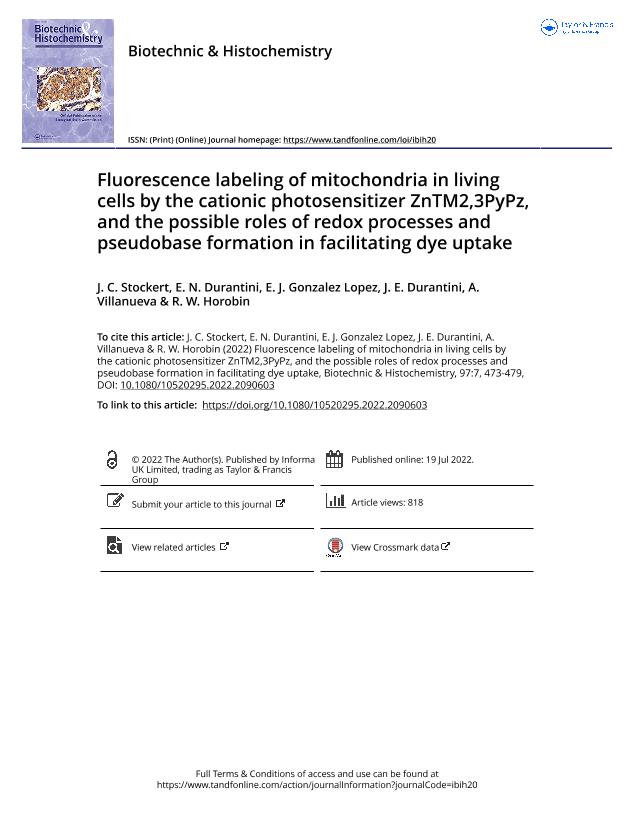Mostrar el registro sencillo del ítem
dc.contributor.author
Stockert , J. C.
dc.contributor.author
Durantini, Edgardo Néstor

dc.contributor.author
Gonzalez Lopez, Edwin Javier

dc.contributor.author
Durantini, Javier Esteban

dc.contributor.author
Villanueva, A.
dc.contributor.author
Horobin, R. W.
dc.date.available
2023-09-06T16:44:59Z
dc.date.issued
2022-06
dc.identifier.citation
Stockert , J. C.; Durantini, Edgardo Néstor; Gonzalez Lopez, Edwin Javier; Durantini, Javier Esteban; Villanueva, A.; et al.; Fluorescence labeling of mitochondria in living cells by the cationic photosensitizer ZnTM2,3PyPz, and the possible roles of redox processes and pseudobase formation in facilitating dye uptake; Informa Healthcare; Biotechnic and Histochemistry; 97; 7; 6-2022; 473-479
dc.identifier.issn
1052-0295
dc.identifier.uri
http://hdl.handle.net/11336/210743
dc.description.abstract
The study of labeling selectivity and mechanisms of fluorescent organelle probes in living cells is of continuing interest in biomedical sciences. The tetracationic phthalocyanine-like ZnTM2,3PyPz photosensitizing dye induces a selective violet fluorescence in mitochondria of living HeLa cells under UV excitation that is due to co-localization of the red signal of the dye with NAD(P)H blue autofluorescence. Both red and blue signals co-localize with the green emission of the mitochondria probe, rhodamine 123. Microscopic observation of mitochondria was improved using image processing and analysis methods. High dye concentration and prolonged incubation time were required to achieve optimal mitochondrial labeling. ZnTM2,3PyPz is a highly cationic, hydrophilic dye, which makes ready entry into living cells unlikely. Redox color changes in solutions of the dye indicate that colorless products are formed by reduction. Spectroscopic studies of dye solutions showed that cycles of alkaline titration from pH 7 to 8.5 followed by acidification to pH 7 first lower, then restore the 640 nm absorption peak by approximately 90%, which can be explained by formation of pseudobases. Both reduction and pseudobase formation result in formation of less highly charged and more lipophilic (cell permeant) derivatives in equilibrium with the parent dye. Some of these are predicted to be lipophilic and therefore membrane-permeant; consequently, low concentrations of such species could be responsible for slow uptake and accumulation in mitochondria of living cells. We discuss the wider implications of such phenomena for uptake of hydrophilic fluorescent probes into living cells.
dc.format
application/pdf
dc.language.iso
eng
dc.publisher
Informa Healthcare

dc.rights
info:eu-repo/semantics/openAccess
dc.rights.uri
https://creativecommons.org/licenses/by-nc-sa/2.5/ar/
dc.subject
FLUORESCENT PROBES
dc.subject
MACROCYCLIC DYES
dc.subject
MITOCHONDRIA
dc.subject
ORGANELLES
dc.subject
PHOTOSENSITIZERS
dc.subject
ZNTM2,3PYPZ
dc.subject.classification
Química Orgánica

dc.subject.classification
Ciencias Químicas

dc.subject.classification
CIENCIAS NATURALES Y EXACTAS

dc.title
Fluorescence labeling of mitochondria in living cells by the cationic photosensitizer ZnTM2,3PyPz, and the possible roles of redox processes and pseudobase formation in facilitating dye uptake
dc.type
info:eu-repo/semantics/article
dc.type
info:ar-repo/semantics/artículo
dc.type
info:eu-repo/semantics/publishedVersion
dc.date.updated
2023-07-05T12:11:08Z
dc.identifier.eissn
1473-7760
dc.journal.volume
97
dc.journal.number
7
dc.journal.pagination
473-479
dc.journal.pais
Reino Unido

dc.journal.ciudad
London
dc.description.fil
Fil: Stockert , J. C.. Universidad de Buenos Aires; Argentina. Universidad Bernardo O'higgins; Chile
dc.description.fil
Fil: Durantini, Edgardo Néstor. Universidad Nacional de Río Cuarto. Instituto para el Desarrollo Agroindustrial y de la Salud. - Consejo Nacional de Investigaciones Científicas y Técnicas. Centro Científico Tecnológico Conicet - Córdoba. Instituto para el Desarrollo Agroindustrial y de la Salud; Argentina
dc.description.fil
Fil: Gonzalez Lopez, Edwin Javier. Universidad Nacional de Río Cuarto. Facultad de Ciencias Exactas Fisicoquímicas y Naturales. Departamento de Química; Argentina. Consejo Nacional de Investigaciones Científicas y Técnicas; Argentina
dc.description.fil
Fil: Durantini, Javier Esteban. Universidad Nacional de Río Cuarto; Argentina. Universidad Nacional de Río Cuarto. Facultad de Ciencias Exactas Fisicoquímicas y Naturales. Instituto de Investigaciones en Tecnologías Energéticas y Materiales Avanzados. - Consejo Nacional de Investigaciones Científicas y Técnicas. Centro Científico Tecnológico Conicet - Córdoba. Instituto de Investigaciones en Tecnologías Energéticas y Materiales Avanzados; Argentina
dc.description.fil
Fil: Villanueva, A.. Universidad Autónoma de Madrid; España
dc.description.fil
Fil: Horobin, R. W.. University of Glasgow; Reino Unido
dc.journal.title
Biotechnic and Histochemistry

dc.relation.alternativeid
info:eu-repo/semantics/altIdentifier/doi/http://dx.doi.org/10.1080/10520295.2022.2090603
dc.relation.alternativeid
info:eu-repo/semantics/altIdentifier/url/https://www.tandfonline.com/doi/full/10.1080/10520295.2022.2090603
Archivos asociados
